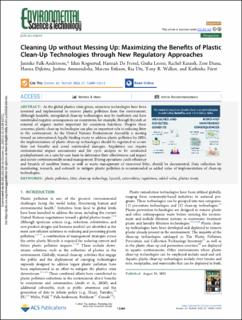| dc.contributor.author | Falk-Andersson, Jannike | |
| dc.contributor.author | Rognerud, Idun | |
| dc.contributor.author | De Frond, Hannah | |
| dc.contributor.author | Leone, Giulia | |
| dc.contributor.author | Karasik, Rachel | |
| dc.contributor.author | Diana, Zoie | |
| dc.contributor.author | Dijkstra, Hanna | |
| dc.contributor.author | Ammendolia, Justine | |
| dc.contributor.author | Eriksen, Marcus | |
| dc.contributor.author | Utz, Ria | |
| dc.contributor.author | Walker, Tony R. | |
| dc.contributor.author | Fürst, Kathinka | |
| dc.date.accessioned | 2023-11-14T13:29:51Z | |
| dc.date.available | 2023-11-14T13:29:51Z | |
| dc.date.created | 2023-09-28T12:02:40Z | |
| dc.date.issued | 2023 | |
| dc.identifier.citation | Environmental Science and Technology. 2023, 57 (36), 13304-13312. | en_US |
| dc.identifier.issn | 0013-936X | |
| dc.identifier.uri | https://hdl.handle.net/11250/3102505 | |
| dc.description.abstract | As the global plastics crisis grows, numerous technologies have been invented and implemented to recover plastic pollution from the environment. Although laudable, unregulated clean-up technologies may be inefficient and have unintended negative consequences on ecosystems, for example, through bycatch or removal of organic matter important for ecosystem functions. Despite these concerns, plastic clean-up technologies can play an important role in reducing litter in the environment. As the United Nations Environment Assembly is moving toward an international, legally binding treaty to address plastic pollution by 2024, the implementation of plastic clean-up technologies should be regulated to secure their net benefits and avoid unintended damages. Regulation can require environmental impact assessments and life cycle analysis to be conducted predeployment on a case-by-case basis to determine their effectiveness and impact and secure environmentally sound management. During operations catch-efficiency and bycatch of nonlitter items, as well as waste management of recovered litter, should be documented. Data collection for monitoring, research, and outreach to mitigate plastic pollution is recommended as added value of implementation of clean-up technologies. | en_US |
| dc.language.iso | eng | en_US |
| dc.publisher | ACS Publications | en_US |
| dc.rights | Navngivelse 4.0 Internasjonal | * |
| dc.rights.uri | http://creativecommons.org/licenses/by/4.0/deed.no | * |
| dc.title | Cleaning Up without Messing Up: Maximizing the Benefits of Plastic Clean-Up Technologies through New Regulatory Approaches | en_US |
| dc.type | Peer reviewed | en_US |
| dc.type | Journal article | en_US |
| dc.description.version | publishedVersion | en_US |
| dc.rights.holder | © 2023 The Authors | en_US |
| dc.source.pagenumber | 13304-13312 | en_US |
| dc.source.volume | 57 | en_US |
| dc.source.journal | Environmental Science and Technology | en_US |
| dc.source.issue | 36 | en_US |
| dc.identifier.doi | 10.1021/acs.est.3c01885 | |
| dc.identifier.cristin | 2179812 | |
| cristin.ispublished | true | |
| cristin.fulltext | original | |
| cristin.qualitycode | 2 | |

